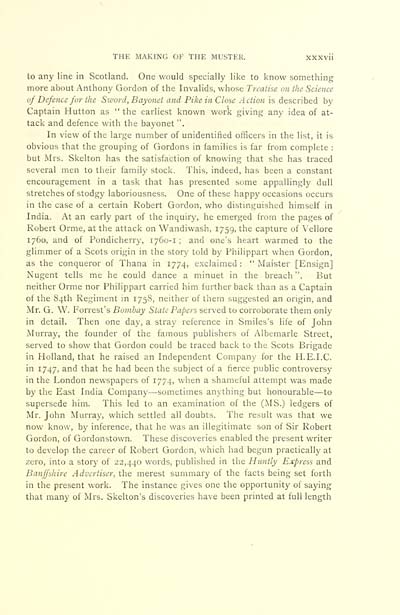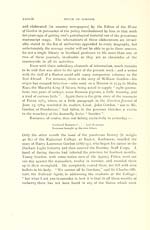New Spalding Club > House of Gordon > Gordons under arms
(47) Page xxxvii
Download files
Complete book:
Individual page:
Thumbnail gallery: Grid view | List view

THE MAKING OF THE MUSTER. XXXvii
to any line in Scotland. One would specially like to know something
more about Anthony Gordon of the Invalids, whose Treatise on the Science
of Defence for the Sword, Bayonet and Pike in Close Action is described by
Captain Button as " the earliest known work giving any idea of at-
tack and defence with the bayonet ".
In view of the large number of unidentified officers in the list, it is
obvious that the grouping of Gordons in families is far from complete :
but Mrs. Skelton has the satisfaction of knowing that she has traced
several men to their family stock. This, indeed, has been a constant
encouragement in a task that has presented some appallingly dull
stretches of stodgy laboriousness. One of these happy occasions occurs
in the case of a certain Robert Gordon, who distinguished himself in
India. At an early part of the inquiry, he emerged from the pages of
Robert Orme, at the attack on Wandiwash, 1759, the capture of Vellore
1760, and of Pondicherry, 1760-1 ; and one's heart warmed to the
glimmer of a Scots origin in the story told by Philippart when Gordon,
as the conqueror of Thana in 1774, exclaimed : " Maister [Ensign]
Nugent tells me he could dance a minuet in the breach ". But
neither Orme nor Philippart carried him further back than as a Captain
of the 84th Regiment in 1758, neither of them suggested an origin, and
Mr. G. W. Forrest's Bombay State Papers served to corroborate them only
in detail. Then one day, a stray reference in Smiles's life of John
Murray, the founder of the famous publishers of Albemarle Street,
served to show that Gordon could be traced back to the Scots Brigade
in Holland, that he raised an Independent Company for the H.E.I.C.
in 1747, ^nd that he had been the subject of a fierce public controversy
in the London newspapers of 1774, when a shameful attempt was made
by the East India Company — sometimes anything but honourable — to
supersede him. This led to an examination of the (MS.) ledgers of
Mr. John Murray, which settled all doubts. The result was that we
now know, by inference, that he was an illegitimate son of Sir Robert
Gordon, of Gordonstown. These discoveries enabled the present writer
to develop the career of Robert Gordon, which had begun practically at
zero, into a story of 22,440 words, published in the Himtly Express and
Banffshire Advertiser, the merest summary of the facts being set forth
in the present work. The instance gives one the opportunity of saying
that many of Mrs. Skelton's discoveries have been printed at full length
to any line in Scotland. One would specially like to know something
more about Anthony Gordon of the Invalids, whose Treatise on the Science
of Defence for the Sword, Bayonet and Pike in Close Action is described by
Captain Button as " the earliest known work giving any idea of at-
tack and defence with the bayonet ".
In view of the large number of unidentified officers in the list, it is
obvious that the grouping of Gordons in families is far from complete :
but Mrs. Skelton has the satisfaction of knowing that she has traced
several men to their family stock. This, indeed, has been a constant
encouragement in a task that has presented some appallingly dull
stretches of stodgy laboriousness. One of these happy occasions occurs
in the case of a certain Robert Gordon, who distinguished himself in
India. At an early part of the inquiry, he emerged from the pages of
Robert Orme, at the attack on Wandiwash, 1759, the capture of Vellore
1760, and of Pondicherry, 1760-1 ; and one's heart warmed to the
glimmer of a Scots origin in the story told by Philippart when Gordon,
as the conqueror of Thana in 1774, exclaimed : " Maister [Ensign]
Nugent tells me he could dance a minuet in the breach ". But
neither Orme nor Philippart carried him further back than as a Captain
of the 84th Regiment in 1758, neither of them suggested an origin, and
Mr. G. W. Forrest's Bombay State Papers served to corroborate them only
in detail. Then one day, a stray reference in Smiles's life of John
Murray, the founder of the famous publishers of Albemarle Street,
served to show that Gordon could be traced back to the Scots Brigade
in Holland, that he raised an Independent Company for the H.E.I.C.
in 1747, ^nd that he had been the subject of a fierce public controversy
in the London newspapers of 1774, when a shameful attempt was made
by the East India Company — sometimes anything but honourable — to
supersede him. This led to an examination of the (MS.) ledgers of
Mr. John Murray, which settled all doubts. The result was that we
now know, by inference, that he was an illegitimate son of Sir Robert
Gordon, of Gordonstown. These discoveries enabled the present writer
to develop the career of Robert Gordon, which had begun practically at
zero, into a story of 22,440 words, published in the Himtly Express and
Banffshire Advertiser, the merest summary of the facts being set forth
in the present work. The instance gives one the opportunity of saying
that many of Mrs. Skelton's discoveries have been printed at full length
Set display mode to: Large image | Transcription
Images and transcriptions on this page, including medium image downloads, may be used under the Creative Commons Attribution 4.0 International Licence unless otherwise stated. ![]()
| Publications by Scottish clubs > New Spalding Club > House of Gordon > Gordons under arms > (47) Page xxxvii |
|---|
| Permanent URL | https://digital.nls.uk/79781261 |
|---|
| Description | Volumes 47-53 are uniform with but not part of the club's series. |
|---|---|

